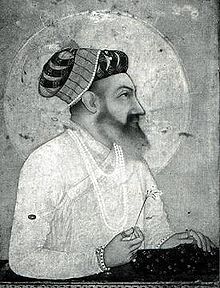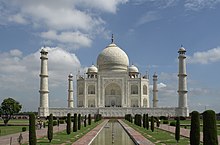Shah Jahan
Shihabuddin Muhammad Shah Jahan ( Persian شهاب الدین محمّد شاه جهان Shihāb ud-Din Muhammad Shāh-i Jahān , DMG Shihāb ud- Dīn Muḥammad Shāh-i Ğahān ) (born on January 5, July / January 15, 1592 greg .; Died on January 22, July / February 1, 1666 greg . ) was the third son of Jahangir, the Great Mughalof India between 1627 and his disempowerment by his son Aurangzeb in June 1658. He was the fifth Mughal ruler after Babur , who was originally a petty prince in Fergana Valley in today's Uzbekistan and founded the Mughal Empire and his successors Humayun , Akbar I. and Jahangir.
He is known as the builder of the Taj Mahal , which he had built as a mausoleum for his favorite wife Mumtaz Mahal .
biography
Shah Jahan or Schāh-i Dschahān (Persian 'King of the World') was born as Prince Khurram ( Persian خرّم 'flourishing', 'happy'). He was his grandfather Akbar's favorite even in his youth. The ancestry of Babur suggests that Shah Jahan is at least on his father's side of Turkish - Mongolian origin.
Prince Khurram married in 1612 at the age of 20 the one year younger Arjumand Banu Begum , called Mumtaz Mahal , whom he loved so much that he never refused a wish and never parted with her, and which he therefore even in the most distant corners of his empire and even on military expeditions. They had 14 children together - eight sons and six daughters - seven of whom survived.
Under the rule of his father Jahangir , who was addicted to opium and alcohol , he proved to be an able military leader in the conquest of Mewar , the last great Hindu principality (1613) and the fortress of Kangra in the Vorhimalaya (1618/20), which was considered impregnable . He also showed an early interest in architecture . Despite the numerical inferiority of his army, he was able to push back the offensive of the Dekkan sultanate in 1621. In 1622 Shah Jahan rebelled against his father and was crushed. He fled through the Dekkan and Orissa , lost again to his father in 1624 and again in 1626. The Sultan of Ahmadnagar finally gave him a small fief ( Iqta ) as a hiding place. Jahangir named his half-brother Shahriyar as heir to the throne.
After Jahangir's death (1627), the vizier Asaf Khan eliminated his rivals on behalf of Shah Jahan. Shah Jahan's half-brother Shahriyar had to be defeated in a first war of succession, the other princes were also murdered or - like Khusrau - had been put out of the way earlier. Only Jahan , his father's favorite wife, was placed under house arrest in Lahore .
When Shah Jahan's favorite wife Mumtaz Mahal died on June 17, 1631 giving birth to their 14th child, Gauhara Begum , the deeply affected emperor fell into great grief. In the first week he did not want to see anyone and no longer bothered about state affairs. He began building her tomb, the Taj Mahal in Agra (1631–1648 / 53), and ordered a two-year state mourning over the next two years . He himself "abstained from all pleasures during this time, did not listen to instrumental music, wore no jewelry, did not use perfumes, no longer ate copious meals, and did not wear expensive garments". During this time, Shah Jahan increasingly withdrew from government affairs in favor of his sons.
Measures against Hindus were taken in 1632. A law ordered the destruction of numerous newly built or under construction Hindu temples, as the Islamic theologians did not want to allow foreign religions to build or renovate new temples. However, it is not clear to what extent this law has been implemented; a total of seven cases of temple destruction during Shah Jahan's reign can be proven. Mughal troops also destroyed the Portuguese settlement on Hugli in 1632, who had attracted attention through piracy, slave hunts and forced conversions and who did not stop at members of the Mughal administration. His early years of reign were guided by the influence of the Orthodox Muslims; the old emperor, on the other hand, under the influence of his son Dara Shikoh (a free spirit like Akbar I at the time , but spoiled by luxury) was more considerate and even promoted Indian music and literature .
The emperor's government was increasingly headed by his eldest son Dara Shikoh - not least because Shah Jahan feared his rebellion and thus hoped to prevent it. The third son Aurangzeb , an energetic, Orthodox Muslim and thus a natural rival of Dara, suffered from this . a. deposed twice as governor ( subahdar ) of the Deccan . There is evidence that Shah Jahan's younger sons allied against Dara Shikoh in the early 1950s.
In addition, the Persians wrested the city of Kandahar from the Mughals in 1649 , a sign of the increasing military weakness of the Mughal army, which princes Aurangzeb and Dara Shikoh could not make up for through personal efforts during three failed sieges. In India itself, the Mughal empire was still expanding: the Deccan sultanates saw the Mughal army before Bijapur ( Sultanate Bijapur ) as early as 1632 , the submission of the Sultanate Ahmadnagar in 1633 and the conquest of Haiderabad ( Sultanate Golkonda ) in 1656 , so that only the final incorporation of the Deccan was still a question of time or was only delayed by the ongoing rivalry between Dara Shikoh and Aurangzeb.
When Shah Jahan was in serious mortal danger because of a urethral problem in September 1657, his younger sons feared Dara Shikoh's accession to the throne in Delhi . Shah Jahan recovered reasonably well, but the fratricidal war could no longer be stopped; the princes were determined to fight the matter militarily. Dara Shikoh made mistakes, and so Aurangzeb was able to prevail against his brothers in the years 1657/58, despite Shah Jahan's secret dislike. After Dara's severe defeat at Samugarh at the end of May 1658, Shah Jahan had to surrender to his son Aurangzeb in Agra. He spent the last years of his life as a prisoner in Agra , overlooking the Taj Mahal. His eldest daughter Jahanara , who had fulfilled the duties of first lady at court since the death of her mother Mumtaz Mahal, cared for him sacrificially. After his death (1666) he was buried at the side of Mumtaz Mahal.
buildings
In addition to the Taj Mahal, Shah Jahan also built the Red Fort in Delhi and the Friday mosque there ( Jama Masjid ). The Friday Mosque of Thatta ( Pakistan ), which was later named after him, also goes back to his initiative. He also worked on the creation of the Shalimar Gardens in Kashmir . However , he largely left the construction of his father's tomb in Lahore (Pakistan) to his stepmother Nur Jahan . He largely entrusted his daughter Jahanara Begum with the construction project for the Friday Mosque of Agra.
See also
literature
- Bamber Gascoigne: The Mughals. Splendor and greatness of Mohammedan princes in India. Prisma Verlag, Gütersloh 1987, ISBN 3-570-09930-X
- Stephan Conermann: The Mughal Empire. History and Culture of Muslim India . CH Beck, Munich 2006, ISBN 978-3-406-53603-8
- Fergus Nicoll: Shah Jahan, The Rise and Fall of the Mughal Emperor , Haus Publishing, London 2009, ISBN 978-1-906598-18-1
- Banarsi Prasad Saksena: History of Shahjahan of Dihli , Central Book Depot, Allahabad 1932, rep. 1962, 1975, 2012, ISBN 978-81-8090-237-6
Web links
- Literature by and about Shah Jahan in the catalog of the German National Library
Individual evidence
- ↑ Ganesh Saili: Taj Mahal (in the series: L'Inde dorée ), French translation by Virginie Troit and David Amehame, PML Editions / Luster Press, New Delhi (India), 1996, p. 39.
- ↑ Ganesh Saili: Taj Mahal (in the series: L'Inde dorée ), French translation by Virginie Troit and David Amehame, PML Editions / Luster Press, New Delhi (India), 1996, p. 40.
- ↑ Eaton, Richard: "Temple desacration and Indo-Muslim states", in: Frontline , January 5, 2001, online at http://www.columbia.akadns.net/itc/mealac/pritchett/00islamlinks/txt_eaton_temples2.pdf .
| predecessor | Office | successor |
|---|---|---|
| Jahangir |
Mughal Mughal of India 1627–1657 |
Aurangzeb |
| personal data | |
|---|---|
| SURNAME | Shah Jahan |
| ALTERNATIVE NAMES | Shabuddin Mohammed Shah Jahan (full name); Prince Khurram (maiden name) |
| BRIEF DESCRIPTION | Indian emperor and builder of the Taj Mahal |
| DATE OF BIRTH | January 15, 1592 |
| DATE OF DEATH | February 1, 1666 |

